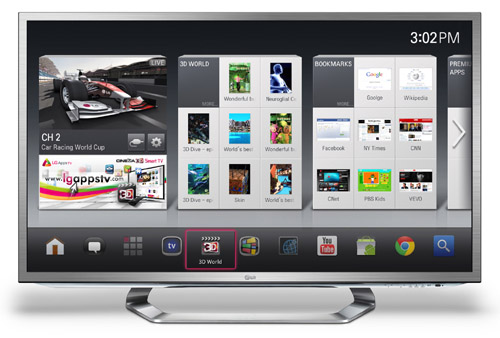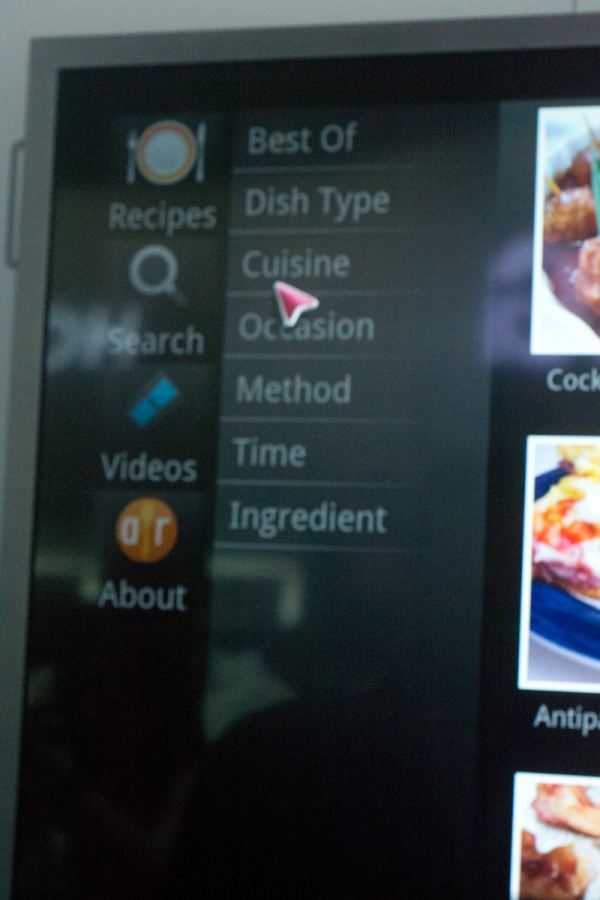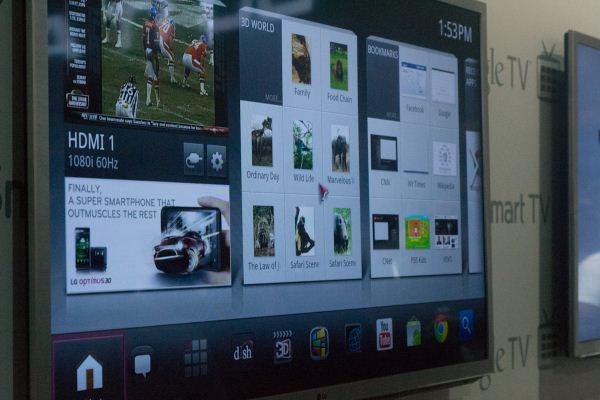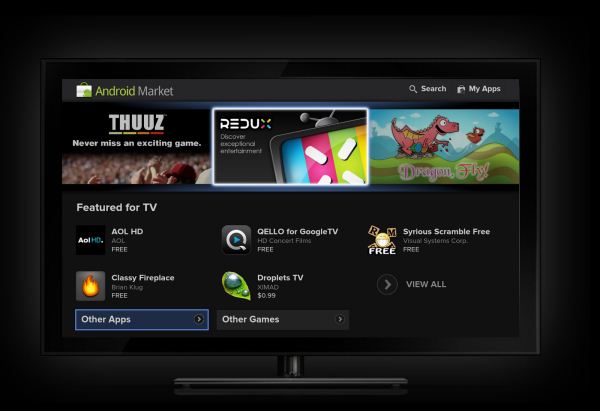LG's G6 Series: A New Kind of Google TV Partnership
by Jason Inofuentes on February 6, 2012 10:43 PM ESTLG and Google TV

The new interface retains the three column format we saw in the earlier designs, though there’s a higher density of shown content. The content panel is smaller, making room for advertising space in the area below it. The middle column remains reserved for featured content, though the content will be targeted based on your device, so on this 3D set, the features were 3D tech demos. The third panel is now labeled Bookmarks, and to this section the user can pin nearly anything, from stored content and apps, to websites and stations. New panels populate additional screens with the left most screen always serving as the primary home screen. Those panels could include a Recent Apps panel, Settings, and perhaps widgets featuring live updated content. The arrangement seems very familiar to any Android user that’s spent time organizing their home screens.
All this is simple enough, and the density is good, not too overwhelming and not cluttered or busy looking. The dock across the bottom compliments the whole experience well, with a size premium provided to icons within the dock. And along the right side of the dock you find the core Google TV apps: Chrome, YouTube, Search and Market. We were lucky enough to have one of the product managers handle our demonstration and his passion for the product was clear. He gestured excitedly at the new icons and how well they coexisted with the icons and UI from LG.

The AllRecipes.com App on LG's Smart TV with Google TV
Surely, I thought, once he clicks on one of those apps, I’ll be greeted by a splash screen and a long delay, as Google TV launches, and then within that instance the Chrome app is opened, or the Market loads. And then it happened, a simple rectangular box, with light grey text, and a font I recognized from the tablet in my bag. The product manager, apologized and reminded me that this was very early software, shipped only days before from their labs in Korea, while scrambling to clear the notification informing us that a background service had stopped responding. That’s when I realized that I wasn’t looking at two OSes set side by side. LG’s Smart TV UI was now an Android 3.2 skin. Google had let them skin Google TV.
The number of Google TV 1.0 products can be counted on one hand, and you’d hardly use all five fingers. Logitech’s Revue was the most successful, and it was a financial disaster for Logitech. Sony produced a television and a Blu-ray Player with the technology built-in. At CES Google introduced several partners in the space including new internal hardware from Marvell and MediaTek, and new product partners in Vizio and LG. The number of products that make it to market will remain relatively small, and will face competition from the myriad OTT solutions that have grown both in number and sales. They’ll also face competition from the likes of Lenovo, who is aggressively repurposing Android 4.0 for their first venture into the TV market, the Lenovo K91. Like all the other K pre-fix denotes a Chinese market product, and few if any of these products make it to US shores. Lenovo’s success in the Chinese TV market could drive efforts to expand globally, though; and beyond that there’s the ever present issue of Google certification.
Google’s Android Market is the value add that they use to leverage control over device manufacturers. As was reported in some legal documents that came to light last year, Google may have acted to block Samsung from releasing certain products because of GPS software implementations. There’s speculation about Google playing favorite’s with some manufacturer’s and stifling down market competition. And all this is muddled when you see that some devices that blatantly break with the speculative standards Google sets for products are granted access to the Market. Recently, in a blogpost on their development portal, Google laid out a new requirement for Market access. Going forward from Android 4.0, device manufacturer’s would be required to build their skins within the Theme framework Google provides, and that at all times, access to the default Holo theme would be retained. While this would still allow for OEM and carrier defined widgets and software preloads, the user would have access to the default core UI. This is something we have been asking for since the Droid Incredible review introduced us to HTC’s Sense UI on Android.
But with Google’s history of having a seemingly arbitrary approval process, it’s difficult to say for sure whether this is more of a soft standard. In business, the rules are simply the starting point for negotiations. Lenovo’s Android 4.0 based solution is purported to have Market access. In a chance encounter with a Lenovo product manager, I was left with the impression that Google had set alternate standards for devices marketed outside of the US. This seems plausible but opens up worries of fragmentations in software. Imagine if an OEM developed a software solution bundled within their skin that had earnest appeal to the end user, an advanced browser for instance. That manufacturer could use this bundling to negotiate access to the Android Market in the US without exposing the Holo theme.
LG wanted to be a Google TV partner. They wanted to have access to the Marketplace, but they wanted to be able to apply their own UI themes. And they were able to negotiate that for Google TV 2.0. What could this mean for later Google TV iterations? We don’t know. As a technology partner, success amongst manufacturer’s is about differentiation. Success amongst consumers is about a consistent user experience. If a mainstream consumer has to relearn how to change channels or access a favorite app, every time they encounter a different television, they will grow frustrated and that will hurt smart TV adoption.
Throughout the rest of the demo there were hiccups, UI stuttering and additional Force Close notifications. Content playback was smooth and the few apps that loaded showed promise. YouTube as a feature on smart TV and OTT solutions carriers a lot of weight, but poses an interesting complication. The vast majority of YouTube content is below standard definition in quality. When stretched across screens larger than a laptop the deficits are ever more pronounced. As HD cameras become more and more ubiquitous (thanks in large part to smartphone adoption), user generated content will improve, but even some professional content can look unpleasant due to compression artifact and poor production quality. Google’s solution seems to be elevating YouTube from a portal for almost entirely user generated content and bringing media partners to provide content. And tying access to this media content through the Android Market could be the leverage Google needs.
Wrap-up
Android skins have been an issue, but generally well accepted by the public. Where confusion strikes is when a user buys an Android device from a competitor, and the e-mail widget is different or the keyboard less friendly. Would the same hold true for a TV? If the core experience (seeking, selecting and viewing content) remained consistent, would users mind a tweaked UI? Google has a long way in proving themselves capable of altering the way we watch televison for the better. Partnering with a manufacturer to make that software experience better may be a good step.













5 Comments
View All Comments
aryonoco - Tuesday, February 7, 2012 - link
"Going forward from Android 4.0, device manufacturer’s would be required to build their skins within the Theme framework Google provides, and that at all times, access to the default Holo theme would be retained. While this would still allow for OEM and carrier defined widgets and software preloads, the user would have access to the default core UI."No no no, this is wrong. This is not what's happening.
The Holo theme has to be present on the device, umodified, so that applications that want to use it can leverage it. The user has absolutely no say in what theme the app will use. OEMs can define their own theme, and Holo has to be present as well. Then, an app developer can either target the device native theme (i.e., the carrier theme) or the Holo theme, or define their own theme if they wish. There is nothing that says that a user has control over this.
"And all this is muddled when you see that some devices that blatantly break with the speculative standards Google sets for products are granted access to the Market."
Can you name one of these products which allegedly break the CTS and legally carry Market and other proprietary Google Apps? Cause I don't know of any, as as far as the ODMs that I've talked to are concerned, there is nothing "speculative" about the CTS. It's out there in the open for anyone to read:
http://source.android.com/compatibility/cts-intro....
Anandtech has for the past two years or so, had the best coverage of the mobile industry and Android in particular, bar none. I would hate for misinformation to be spread around via this credible source, without any credible evidence.
JasonInofuentes - Tuesday, February 7, 2012 - link
I appreciate the clarifications. After looking into it and talking to Brian, you're right, I got the Holo theme details wrong, and will update as suited. As far as the Market access rules though, this is a situation that has improved significantly of late, but is not so cut and dry as you think.The CTS ensures that a device meets a certain technical compatibility with Android and with Android apps, however it is not the only hurdle that must be met to obtain Market access. From the CTS FAQ:
"If my device is compatible, does it automatically have access to Android Market and branding?
Android Market is a service operated by Google. Achieving compatibility is a prerequisite for obtaining access to the Android Market software and branding. Device manufacturers should contact Google to obtain access to Android Market."
The Android Market is the value add by which Google leverages power over device manufacturers. When a company approaches Google with a CTS compliant device and seeks access to the Android Market, they negotiate an agreement and based on their compliance with the agreement they do or do not receive access. These agreements are private and covered by NDAs and rarely see the light of day. The last time one did was during the proceedings of a lawsuit brought by Skyhook, against Google.
The Verge (nee This Is My Next) covered this matter when it broke. (http://www.theverge.com/2011/05/12/google-android-... In that instance the devices in question had Market access revoked late in the product development cycle because of a dispute over which location service would be used. Ultimately, Samsung complied with Google's requests, and it seems likely that as a result of this exposure the CTS and ACD were made public (note that the CDD, previously the ACD, is on just its second revision as of last month). Making these things public removes the threat implicit of having to comply by a hidden document (and the license agreements exposed in the lawsuit make it clear that previously the CTS and ACD could be changed up until the moment of product release). But just because the CTS and ACD are public doesn't mean that Google must grant access to all products that meet CTS and ACD.
As far as examples of device that seemed to breach the assumed contents of the previously unpublished ACD? The OG Galaxy Tab is a good example. Prior to Samsung's Tab, several smaller manufacturer's (Viewsonic and Craig come to mind) had produced Android based tablets. None of them was granted Market access and the operating theory was that a cellular data modem and some form of telephony were a requirement for access; this was a safe assumption since Android was designed for phones, and up until the iPad, tablets seemed a niche market. But when the Galaxy Tab was announced it was noted as featuring the Android Market.
Even turning to Lenovo's announcement can show the lack of clarity. Lenovo's K91 one-ups Google itself by bringing ICS to TVs well ahead of Google's expectations, and is touted as having Market access. It's also acknowledged to be a Chinese market-only device. One problem: The Android Market isn't yet available in China, and possibly never will be. Ignoring the question of whether Market will ever reach China, does this mean that if Samsung chose to produce an ICS-based Smart TV that they would be granted Market access? It would be against Google's best interests to empower a manufacturer to fork Android-based TV's into Google TV's and Other.
Again, with a published CTS and the ACD/CDD this process is much clearer, but it's still ultimately a business negotiation the details of which are not known to the public, and this can lead to confusion.
aryonoco - Wednesday, February 8, 2012 - link
Thank you for your reply and clarification.You bring up good points about the CTS and Market certification. The original Galxy Tab was indeed an anomaly, and the recent Lenovo Android TV announcements had me puzzled as well.
I do however think that for the most part, this ambiguity is a reflection of fine balance that the CTS has to struck, in order to preserve compatibility and avoid fragmentation, while at the same time allowing Android to innovate and continue exploring new territories (like tablets, and now TVs). In order to perform such a function, the CTS has to be updatable by its nature to reflect the current versatility and maturity of the platform.
I think many of these ambiguities in Market certification and Google' reluctance to see Android deployed in areas it had not been designed to are a result of Android's earlier lack of suitability to scale in these areas. With ICS, a single platform can indeed scale from a 3" smartphone to a 70" TV and everything in between, while preserving app compatibility and layout. The newfound openness in the CTS probably also reflects that Google feels confident in the maturity of the platform, and that it can withstand challenges of being deployed in widely different environments.
Having said that, I wholeheartedly agree with you that the situation is less than completely transparent and less than ideal. It would be to everyone's advantages if the rules were out in the open, and merely complying with the CTS would guarantee Market certification. Unlike you, I don't think Google would actually lose anything if a manufacturer ran a fully-compliant ICS in their TV with access to Market, as opposed to the official Google TV. They both equally serve Google's intended purposes well.
8steve8 - Tuesday, February 7, 2012 - link
companies are so silly, trying to differentiate for the sake of differentiation...use google's 'skin', and the industry will have a familiar, clean, reliable, fast interface...
all these efforts at differentiation in android is only hurting the entire android movement.. LG/samsung etc suck at ui design... even if they were good, its an unnecessary tangent.
They all think consumers care/value their additions/customizations, which is blatantly false and maybe egotistical.
KalleSverige - Thursday, May 3, 2012 - link
Man, you are so wrong. Companies and Android phones need differentiation - even much more than today! Otherwise we'll have a boring ecosystem of similar look&feel Android devices. No matter what proprietary UI skins they have you can still clearly say what OS platform is giving those devices their kicks.If you are happy with "clean" and "reliable" user interface of Android, I strongly recommend that you stick with Google Nexus year 2009 model and enjoy your 4 colors on it.